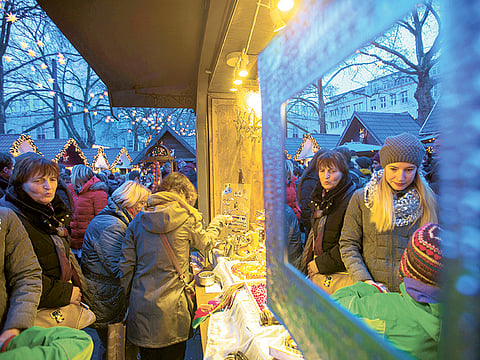Euro-area economy grows 0.3% in Q3 on consumption
Data come after the ECB cut one of its main interest rates to a record low

Brussels: Euro-area growth in the third quarter was bolstered by private consumption and government spending as exports suffered from a slowdown in global trade.
Gross domestic product in the 19-nation bloc rose 0.3 per cent in the three months through September after expanding 0.4 per cent in the prior quarter, the European Union’s statistics office said on Tuesday in Luxembourg, confirming a Nov. 13 estimate.
The data come less than a week after the European Central Bank cut one of its main interest rates to a record low and expanded its asset-purchase program to at least 1.5 trillion euros ($1.6 trillion) to shore up the region’s muted economic recovery and bring inflation closer toward 2 per cent. While domestic spending is benefiting from lower oil prices, exports are damped by an economic slowdown in emerging markets.
“The recovery remains very much a consumption-driven story going into 2016, and the external side should turn from neutral to slightly positive next year,” said Holger Schmieding, chief economist at Berenberg Bank in London. “We have a dent caused by emerging markets, but the risk has lessened over the last two months.”
The euro was little changed after the report and traded at $1.0846 at 11:56am. Frankfurt time.
Domestic Demand
Government spending climbed 0.6 per cent in the third quarter from 0.3 per cent in the previous three months, and household consumption accelerated to 0.4 per cent from 0.3 per cent. Gross fixed capital formation was unchanged from the second quarter, when it rose a revised 0.1 per cent. Exports were up 0.2 per cent and imports increased 0.9 per cent. From a year ago, the 19-nation economy expanded 1.6 per cent, according to Eurostat.
“The slowdown in exports was particularly discouraging,” said Jack Allen, European economist at Capital Economics Ltd in London. “We view this as an early sign that the boost from the euro’s depreciation is starting to fade, and expect it to fade further next year. In terms of fiscal spending, we see the shackles loosening a little more in 2016 as austerity is scaled back.”
The ECB presented fresh economic projections on Dec. 3 that were largely unchanged from September, even as ECB President Mario Draghi pointed to downside risks emanating from “heightened uncertainties regarding developments in the global economy as well as to broader geopolitical risks.”
The central bank kept its growth forecast for next year at 1.7 per cent, and revised a 2017 projection to 1.9 per cent from 1.8 per cent. The inflation outlook for 2016 was cut to 1 per cent from 1.1 per cent, and lowered to 1.6 per cent from 1.7 per cent for the following year.
Against the backdrop of steady, if slow, economic growth in the euro area, policymakers agreed last week on additional stimulus including an extension of quantitative easing by six months until at least March 2017, a broadening of asset eligibility to local and regional debt, and a cut in the deposit rate to minus 0.3 per cent. While Draghi assured observers that the measures were “adequate” and Vice President Vitor Constancio said governors agreed on “exactly what the Executive Board proposed,” financial markets sent the euro soaring and stocks and bonds tumbling in a sign that more ambitious action was expected.
Sign up for the Daily Briefing
Get the latest news and updates straight to your inbox



